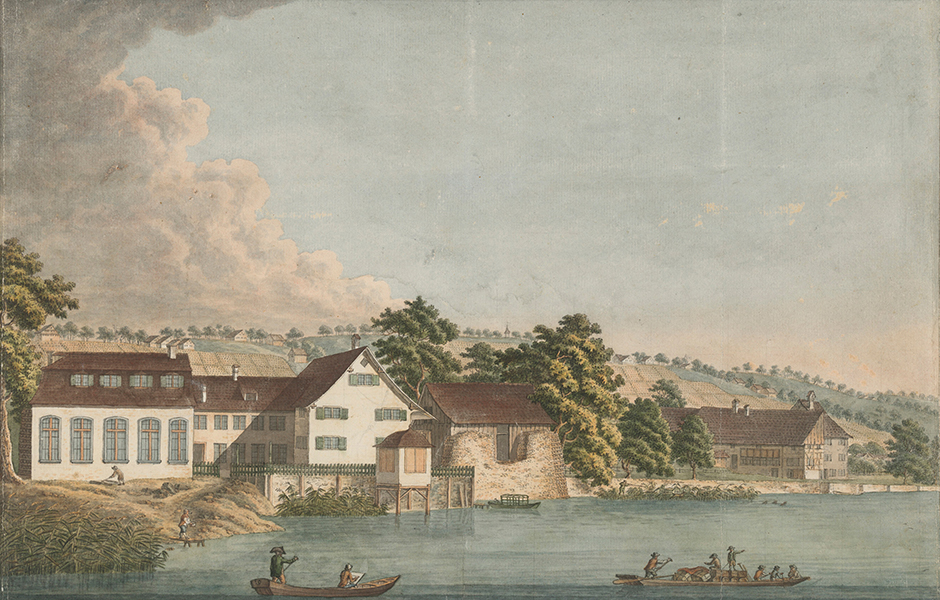
The Zurich porcelain manufactory in Kilchberg-Schooren (original artwork in the Zentralbibliothek Zürich, collection of graphic works).
Zurich porcelain in CERAMICA CH
The Zurich porcelain manufactory
Company history
Elisabeth Lott, 2023
In 1763, a group of politicians, entrepreneurs and intellectuals from Zurich, a city state run by the upper-class bourgeoisie, embarked on the ambitious venture to establish a porcelain manufactory, in a country that could not rely on the patronage, representation or financial means of a princely court. Inspired by the ideas of the Enlightenment, the company’s founders were mainly driven by cultural motives. They wanted to prove that it was possible to build an ambitious artistic enterprise in Zurich while also pursuing economic and philanthropical interests. The idea, on the one hand, was to prevent Zurich customers from spending their money on foreign-produced porcelain and, on the other, to offer artistic education and employment to young people from impoverished rural backgrounds.
The initiative to start up a porcelain manufactory originally came from Johann Conrad Heidegger (1710-1778), who would later become mayor of Zurich, and was based on economic considerations. In 1763, he established a consortium with both his nephews, the well-known poet and painter Salomon Gessner (1730-1788) and the publisher Heinrich Heidegger vom Kiel (1738-1823), and his wife’s, the silk merchant and financier Hans Martin Usteri (1738-1790) and the town clerk Heinrich Lavater (1731-1818), with the specific aim of producing porcelain. On 10th August 1763, Heinrich Heidegger, acting on behalf of the consortium, purchased a residence and grounds in the Schooren area near Kilchberg-Bendlikon on Lake Zurich from the widow Holzhalb. Around the same time, in August 1763, Adam Spengler (1726-1790) was hired as the company director and chief technical officer. Spengler immediately began setting up the manufactory and the first faience vessels went on sale as early as the spring of 1764. Spengler was familiar with the production and processing of this type of pottery from his previous work at faience factories in the Bern region.
By the end of that year, the manufactory had begun to make its first porcelain items and by 1770 it was already producing a wide range of tableware, utilitarian objects and porcelain figures. The expertise in the field of porcelain making probably originated from Ludwigsburg.
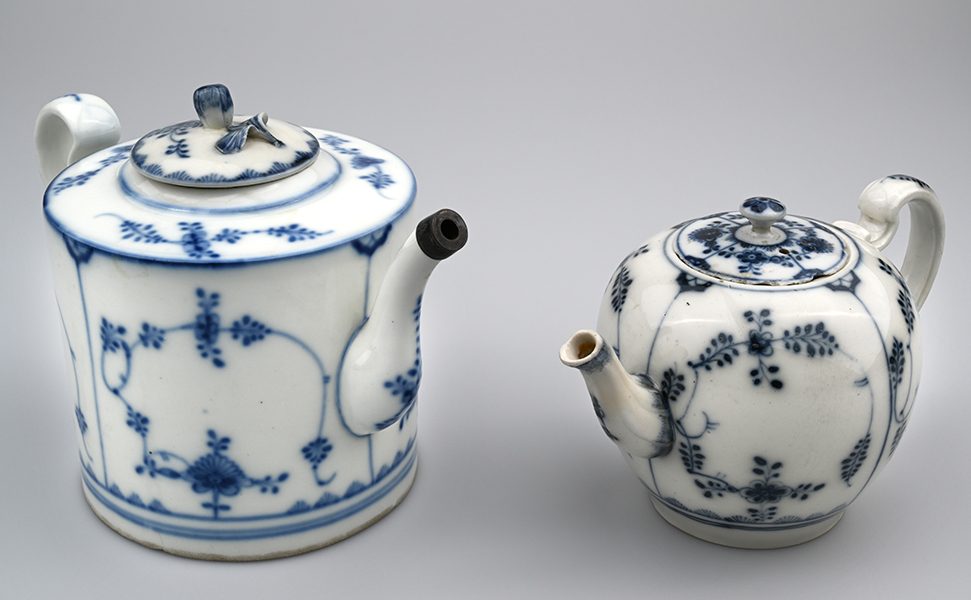
A simple teapot in the Neo-classicist style on the left (CFMH_Bö_0469) and a teapot in the old style on the right (CFMH_Bö_0248).
While the outcome can undoubtedly be seen as successful from the point of view of quality of the products, which could indeed compete with those from renowned porcelain manufacturers from abroad, the same, unfortunately, cannot be said for the economic and financial aspects of the enterprise. It was not long after production began that the company had to grapple with liquidity problems and insufficient yields. The sales market was limited, and foreign competition was fierce. Measures such as experimenting with cheaper clay mixtures with smaller amounts of kaolin or running a porcelain lottery (1773) did not improve matters, nor did a large order from the Zurich Council for the substantial Einsiedeln service (1775). Cash flow problems also meant that the manufactory was not able to invest in new shapes to cater for the modern Neoclassicist taste of the late 18th century but instead remained wedded to the old Rococo style.
Salomon Gessner died in 1788, followed by both Hans Martin Usteri and company director Adam Spengler in 1790, which meant that the manufactory lost most of its management team. Due to the dire financial situation, the remaining stakeholders decided to cease production and liquidate the company after only 27 years in business.
Preparation of the books and liquidating the company’s assets took quite a long time. The binding liquidation certificate was not issued until 31st December 1791. As well as losses of 225,000 Gulden (which today would amount to tens of millions of Swiss francs), it also listed the liabilities of each individual stakeholder. The buildings and grounds were sold and were used in subsequent years by successive Kilchberg enterprises (Neeracher manufactory, 1792-1802; Nägeli manufactory, 1802-1858; Staub manufactory, 1858-1906) as premises to produce faience and refined white earthenware.
Operations and staff
When production began, the Zurich porcelain manufactory employed approximately 30 members of staff. By the standards of the time, the company was quite large. When the residence was bought in 1763, it had 25 rooms. It was converted into an artisanal manufacturing plant, and until 1766, it also served as a home for the director and his family. Separate premises were used for some of the tasks, as was commonplace in other manufactories of the period; these included the “slurry room”, where the raw materials were washed, processed and mixed; the throwing shop, where all shapes that had to be made on a potter’s wheel were produced and worked; the modellers’ and repairers’ shop, where the individual components were pressed into plaster of Paris moulds and then joined together to form the finished piece. Quality control took place in the sorting room, where the glost-fired pieces were checked for flaws and then passed on to the painting or printing shops for decoration. The kilns, which were probably similar to the model developed by Joseph Jakob Ringler from Vienna or the Picollpasso-type vertical updraught kilns commonly used in faience production, were initially installed in the main building; by 1771, however, they had already been moved to a separate building.
Apart from the glaze crusher in Thalwil, none of the stages in the process involved technology, but were instead all carried out by hand. Efficiency was further impaired by the fact that both porcelain and items made from local clay were produced simultaneously.
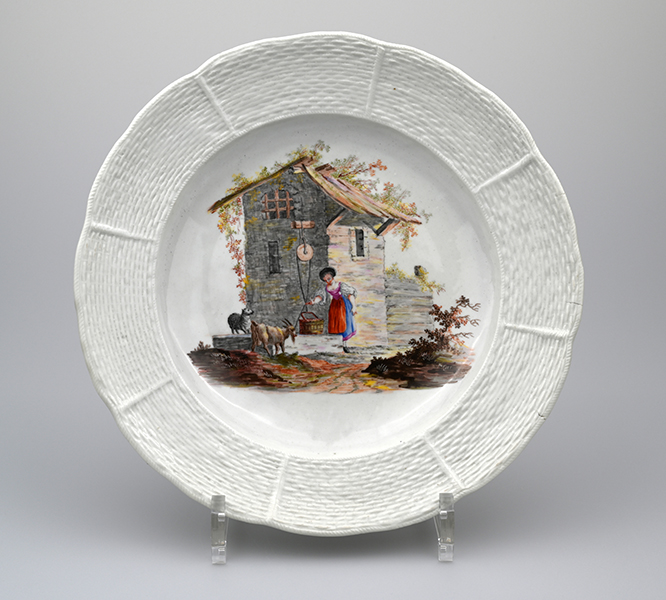
Plate with a landscape painted by Salomon Gessner (CFMH_Bö_0498).
On the other hand, the Zurich manufactory was blessed from the outset with the presence of two highly competent artisans in Salomon Gessner and Adam Spengler. Despite this, the company still had to hire several qualified members of staff from abroad, who were skilled porcelain painters and competent in the different production techniques. Most originated from Lorraine and southern Germany. The painters Johannes Leopold Daffinger from Vienna and Johannes Bonlander from Memmingen as well as the German sculptors and modellers Joseph Nees and Johann Valentin Sonnenschein are worth mentioning.
The specialists from abroad were joined by a team of local workers, most of whom came from Zollikon, and were trained in the modelling and painting shops of the company before becoming known in their own right as artists in the fields of porcelain sculpting and pottery painting. This meant that one of the goals of the founders of the Zurich manufactory had indeed been achieved, and the company did play a role in training artisans. Several well-known Zurich painters, including Heinrich Füssli, Heinrich Thomann and Johann Heinrich Bleuler, were trained at the porcelain manufactory. Johann Jakob Willhelm Spengler, Adam Spengler’s son, also received his artistic training at the manufactory, and became a renowned modeller.
Verarbeitete Materialien
Materials used
At the beginning, the manufactory exclusively used local clays to produce mainly faience, because the director, Adam Spengler, was familiar with this type of ware. However, the first porcelain products were made just a few months later. Experiments were repeatedly carried out to change the composition of the clays used at the Zurich manufactory, in part for financial reasons. Importing kaolin, which was needed to make porcelain, from clay pits in the Bavarian Forest and later from kaolin pits at St. Yrieix near Limoges, was very costly, and because porcelain required significantly higher firing temperatures compared to faience, fuel costs ultimately also contributed to the high production outlays.
Apart from faience and porcelain, the company also produced refined white earthenware and soft-paste porcelain (on the early days of the manufactory: Angst 1905; in contrast see Schnyder 2009, 13-14 who makes a case for a later date for soft-paste porcelain after c. 1777). The studies by Annamaria Matter (2012, 39-48) and Christian Maire (2008, 29-36) are indispensable when it comes to discussing the wares and their definitions. According to chemical analyses (Matter 2012, Tab. 1-3), the refined white earthenware from Kilchberg-Schooren appears to have been made from an iron-deficient, calcium-rich clay mixture, which could be decorated with a lead or faience glaze, leading to problems when it comes to classifying it as refined white earthenware or faience. In CERAMICA-CH, vessels of this type have been classed as faience.
Shapes and decorations
Shapes
The Zurich manufactory produced a huge range of types, both in terms of figures and in terms of crockery and other everyday items. The aim was to offer customers as wide a variety of shapes, as they were used to seeing from rival companies abroad. Contrary to German and French firms, however, the Zurich manufactory was intent on producing less opulent porcelain. The tableware had to appeal to the more understated taste of Protestant bourgeois families in Zurich, who were not interested in the ostentatious and richly decorated models prized by European aristocrats. Furthermore, the exquisitely painted motifs were all the more beautiful on the simpler forms and smooth surfaces.
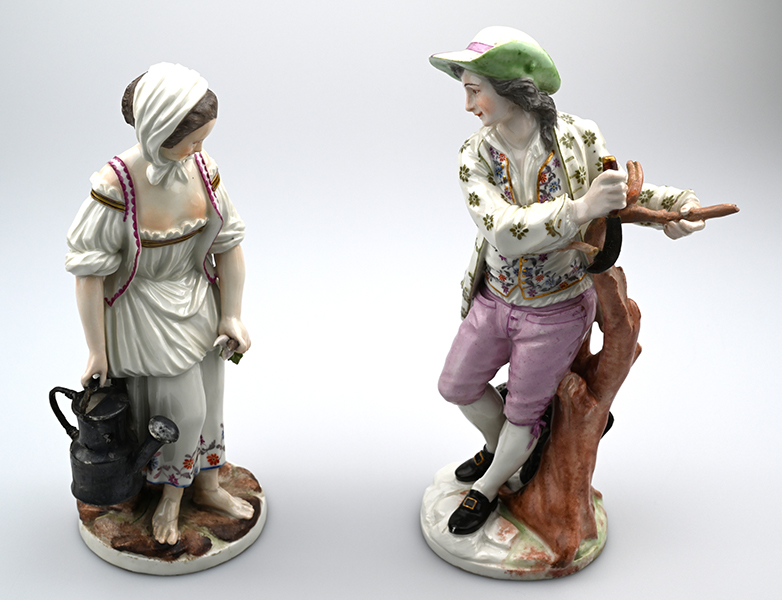
Pair of figures, the gardener and his wife (CFMH_K_0225 and CFMH_K_0226).
The rich array of figures were not intended for decoration in the modern sense but were used exclusively to brighten up the table on feast days or on special occasions. The production of porcelain figures, be it individual ones or groups, involved different artists and artisans than the production of tableware. The allegorical miniature statues representing different crafts and professions, the seasons, the continents or the senses, were some of the sweetest and prettiest displays in the Rococo period. With a repertoire of over 460 different types, the Zurich manufactory was one of the leading companies in Europe in this field (on the figures see also Schnyder 2009).
Decorations
In the 18th century, the choice of colours was still quite limited and some had flaws; green, for example, cracked rather easily. The colours were made from earth pigments, minerals and metals. Blue, for instance, required smalt or cobalt glass. Because ready-to-use porcelain colours were not yet available, manufacturers had no choice but to make their own. Apart from underglaze blue, the Zurich painters used low-temperature or “muffle” colours which were applied to the glazed and muffle-fired pieces. The term “muffle” derived from the fire-resistant chamber or box in which the objects were enclosed to protect them from the flames and smoke during the firing process. One of the difficulties in porcelain painting was the fact that the colours looked completely different before and after firing. In order to gauge how the colours would appear after firing, painters used fired sample plates which showed the range of colours.
In terms of the decorations, the Zurich porcelain manufactory’s products were again highly varied. The floral and landscape motifs were particularly popular. In comparison to those of other manufacturers, their motifs were some of the best-quality examples of ceramic painting ever created.
Landscapes: Under the influence and guidance of Salomon Gessner, the company placed a lot of emphasis on creating wares painted with landscapes. Gessner instructed the porcelain painters in creating idyllic landscape, focusing on the importance of naturalistic designs on the one hand and taking great care to adhere to the strict principles of classic composition on the other. Gessner himself prepared numerous templates of landscape motifs, for which he took much inspiration from engravings by the Dutch Masters.
In contrast to the products from well-known foreign manufactories, the Zurich motifs lacked landscapes or scenes involving aristocratic lifestyles and princely palaces or gardens. The artists in Kilchberg created wares in a sober and business-like style typical of Zurich, although some of their landscapes were of an unparalleled dreaminess and sophistication.
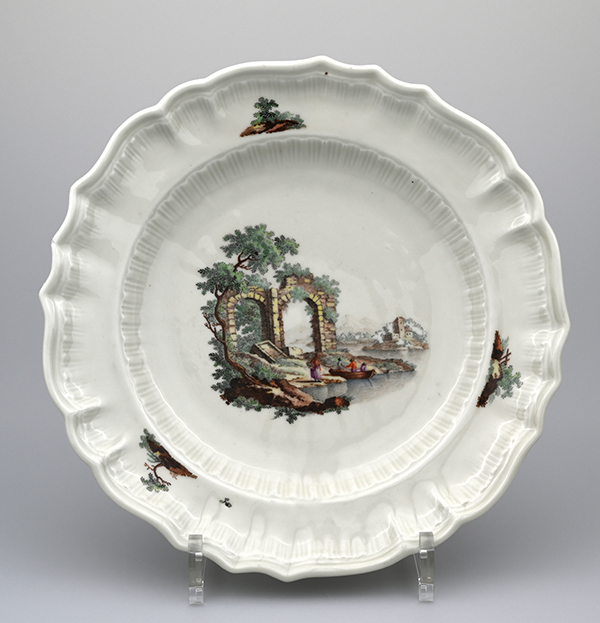
Arcadian landscape (CFMH_Bö_0439).
Today we classify the Zurich landscapes on the basis of their central themes:
– Scenes where the landscape itself was the central theme. Here we distinguish between “arcadian” landscapes on the one hand, where the theme was largely inspired by the graphic designs of artists from Switzerland and abroad, and was either a straight-forward copy of an entire work of art or at least a reproduction of its main components, and “naturalistic” landscapes on the other, where the compositions were created by the artists employed by the manufactory. In these cases, the graphic designs by artists from abroad purely served as a source of inspiration.
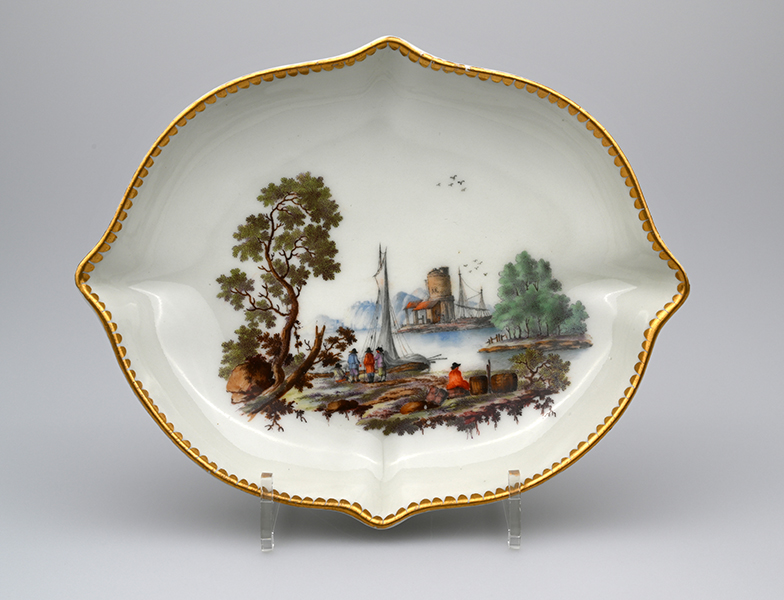
Mercantile shipping scene on a stand (CFMH_Bö_0184).
– Scenes where the landscape is only one of two central themes. Usually, they include boats or ships used fishing or transporting goods. Combined with barrels, bales of wares and other goods in transit waiting on shore to be loaded onto vessels, they make up the Kauffahrtei (mercantile shipping) style of the Zurich merchants. After all, sea routes were still a major component in the exportation of goods to the south.
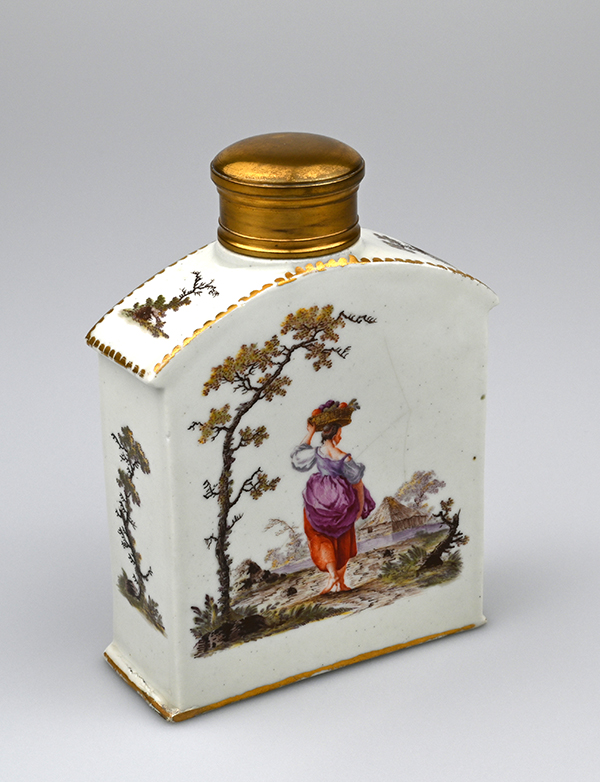
Tea caddy bearing a “Large Figures” design (CFMH_K_1666).
Large Figures designs were closely related to the landscape motifs. The difference was that the people and animals depicted were disproportionately large compared to their surroundings.
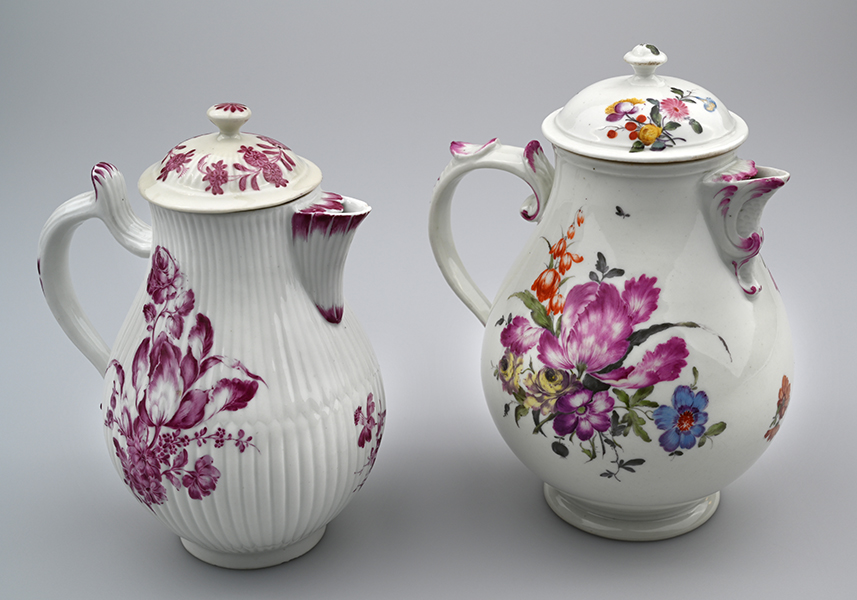
Coffee pots, one with a monochrome design, the other with a polychrome floral pattern (CFMH_Bö_0458 and CFMH_Bö_0338).
Floral designs: While Salomon Gessner was influential in creating landscapes, Adam Spengler inspired his painters with his floral designs, introducing his artistic experience of Bernese faience manufacture to the paint shop in Zurich. As a consequence, the early designs were quite similar to the Bernese floral designs. The Zurich artists not only took their inspiration from the local flora, but also from the designs of other manufacturers, mainly those in Strasbourg and Ludwigsburg.
When it came to depicting naturalistic indigenous flowers, the Zurich painters created masterpieces; highpoints in the early period included lavish and detailed paintings of floral sprays in vibrant colours and the so-called Einsiedeln flowers in the style of Johann Daffinger.
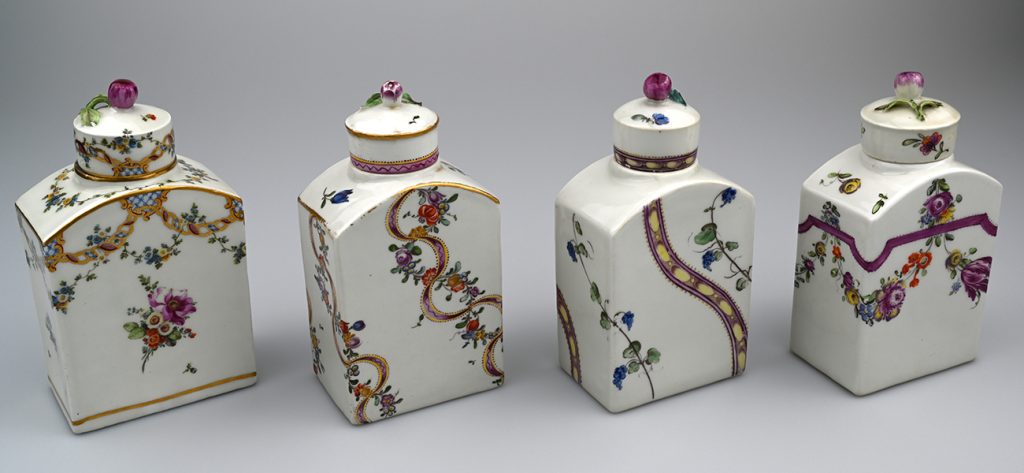
Tea caddies with flower garlands (from left to right: CFMH_Bö_0326, CFMH_Bö_0096, CFMH_Bö_0492, CFMH_K_1524).
Apart from individual flowers or sprays, the Zurich artists also created designs consisting of floral garlands or combinations of garlands, ribbons and other decorative elements such as festoons. We therefore distinguish between actual floral designs and garlands and ribbons.
East Asian designs: The Meissen painters very quickly began to adopt East Asian motifs to decorate their European porcelain wares, modelling them on the pieces in the porcelain collection of Augustus the Strong, Elector of Saxony and King of Poland. Their main source of inspiration was the style of painting seen on Arita and Imari porcelain and, in particular, the Kakiemon style, which imitated Japanese motifs. When it came to figurative motifs, on the other hand, the European painters mainly turned to engravings with themes from the Far East and “exotic people from the Far Eastern lands”.
While Chinese and Japanese artists focused mainly on the symbolic content and graphic quality of the image components and how they were combined to form a whole, the artists employed by the European manufacturers put most of their effort into the aesthetic aspects. They were obviously unaware of the symbolic meanings of the images on Chinese and Japanese ceramics.
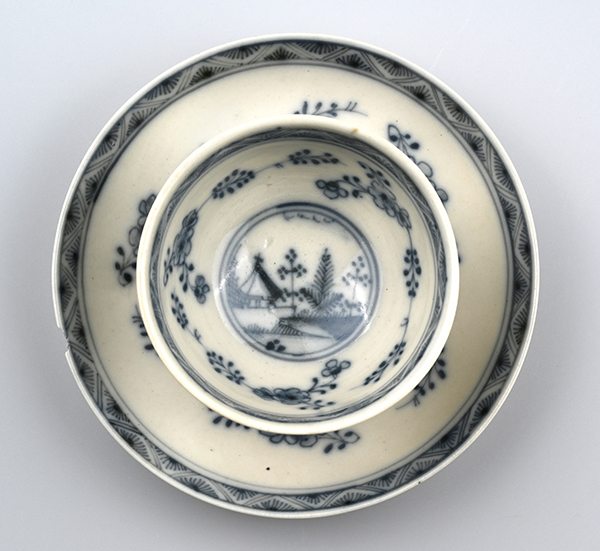
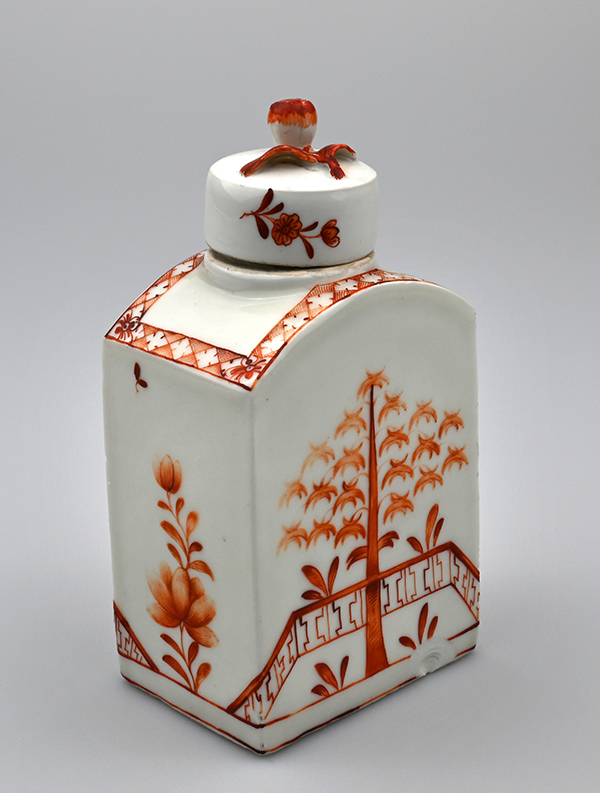
Asian motifs on Zurich porcelain (CFMH_Bö_0307, CFMH_Bö_0135).
In contrast to the Meissen painters, who had access to East Asian ceramics, the painters at the Zurich manufactory had to draw their inspiration from the East Asian motifs created by renowned European porcelain manufacturers. This is attested to by designs such as “asters and paeonies”, “landscape with pagoda”, “rock and bird” and the “Stadler Chinese”, which were clearly copied from Meissen porcelain. When choosing their subjects, the Zurich painters limited themselves to flowers, petals and shrubs as well as rocks, stones and hedgerows. The only animal designs used in Zurich were birds; dragons, lions and tigers were not part of the repertoire.

Plate (CFMH_Bö_0159), coffee pot (CFMH_K_0585) and teapot (CFMH_Bö_0545) with bird designs.
Birds and fruits: The Zurich bird designs included naturalistically painted fowl as well as exotic birds and fanciful creatures that did not exist in reality. We distinguish between “landscapes with birds” and “birds on branches”.
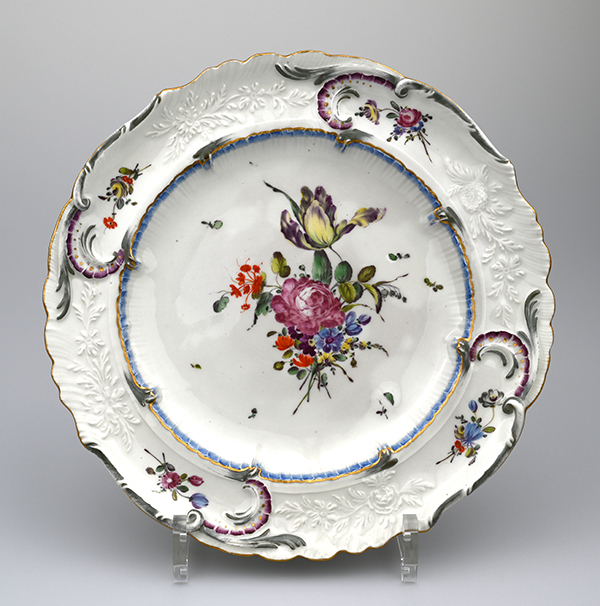
Plate with “corniche” design (CFMH_Bö_0391).
Many of the products from Kilchberg have moulded relief decoration inspired by objects from European manufactories, ranging from simple ribbing with ribs of varying thickness to basket-weave (ozier) patterns on the rim and the so-called “corniche” design which was similar to the more elaborate relief designs from abroad and was composed of flowers and ribbons as well as rocailles. The most popular moulded design on porcelain plates, shallow dishes and bowls from Zurich was fluting. A few individual pieces also have roped rims, a combination of fluting with a plaited or roped edge.
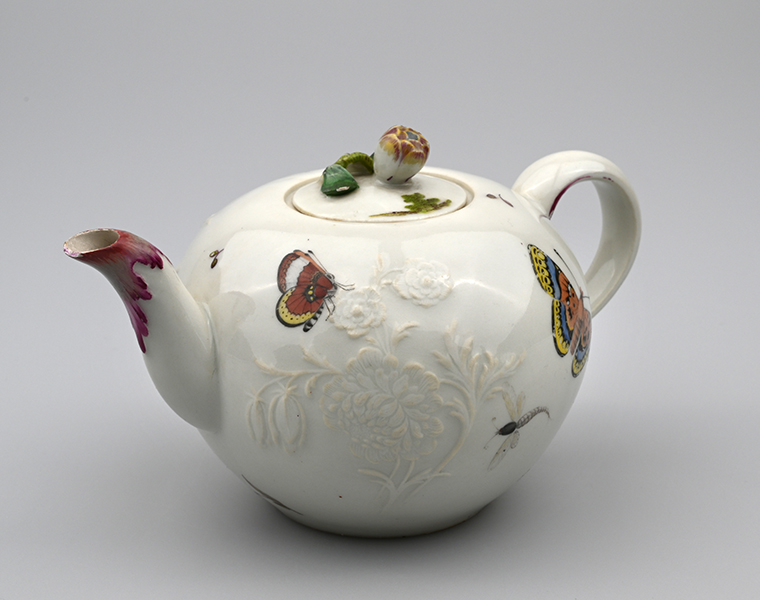
Teapot with a moulded Gotzkowski design combined with painted insects (CFMH_Bö_0275).
Coffee and teapots were sometimes decorated with the so-called Gotzkowski design. Adopted from the Ludwigsburg manufactory, the design consisted of moulded floral tendrils.
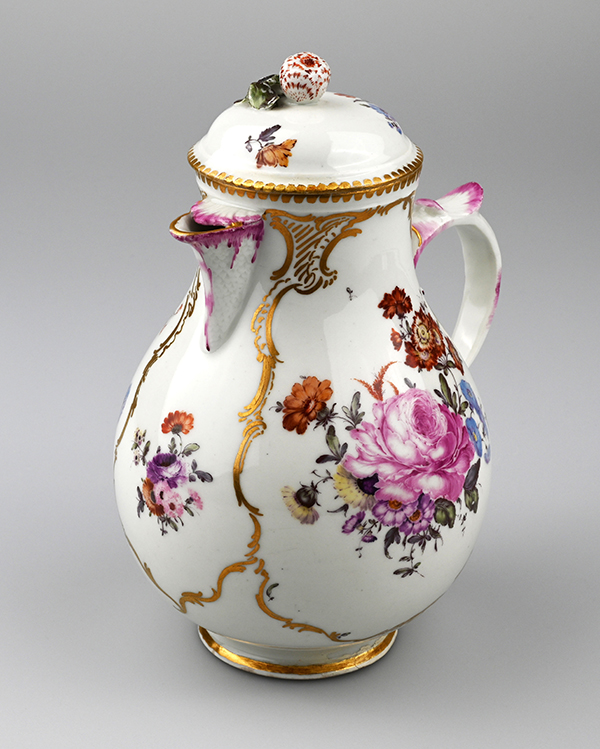
Coffee pot with floral decoration and rich gilding (CFMH_Bö_0493).
Gilding was another decorative element. It ranged from simple gold dots to discrete contour lines in gold, to gold edges and Goldzahnbordüren, as well as rich gilding similar to that found on luxury vessels from Meissen and Sèvres.
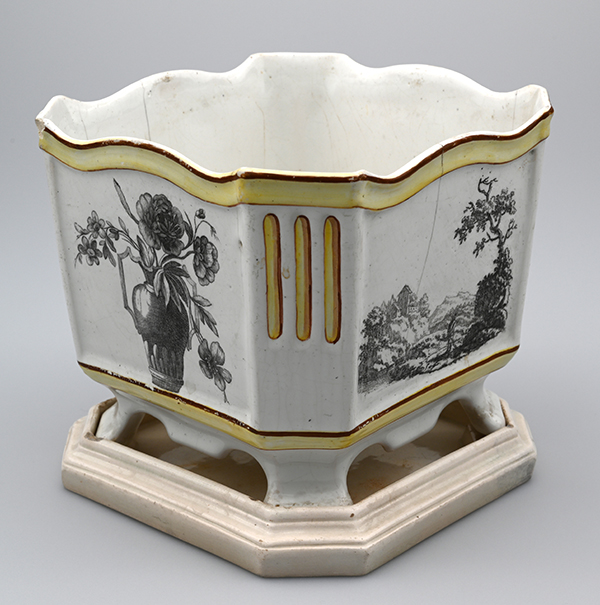
Flower/plant pot container with faience glazing and black overglaze transfer-printed decoration (CFMH_Bö_0274).
In later years, the Zurich porcelain manufactory was one of the first firms in mainland Europe to adopt the technique of transfer-printing. Invented in England, the technique offered a cheaper way of decorating pottery, in particular faience-glazed wares and light-coloured clays. All transfer-printed decoration in Zurich was applied on the glaze.
Services
The Zurich manufactory very rarely produced entire services. If a customer wished to purchase a complete service, or set of tableware, matching individual pieces were assembled from the Schooren warehouse. The actual manufactory shop was located in the “Meisen” building on Münsterhof in Zurich.
Only two complete sets of tableware were ever produced as such: the famous porcelain service commissioned by Einsiedeln Abbey, the only 18th century Swiss state service ever produced, and a faience service commissioned by the von Salis family, which was decorated with beautiful lacustrine landscapes.
The Einsiedeln Service
One of the most important products in the repertoire of the Zurich porcelain manufactory was a set of tableware, known as the “Einsiedeln Service”, which consisted of some 235 individual parts. Made in 1775 it included a generous dinner-service, a coffee-service and a tea-service.
In 1773/74, a delegation of six people from Zurich were sent to negotiate fishing and shipping rights on Lake Zurich with the Stand (= estate, an archaic name for canton) of Schwyz. During the negotiations, which were carried out over a period of several months, the members of the delegation were offered accommodation at Einsiedeln Abbey. The Council of Zurich commissioned the Zurich porcelain manufactory to produce a large service to present to the abbot to thank him for his generosity. The guide price was capped at between 1000 and 1200 Gulden. The commission was extremely welcome in Kilchberg-Schooren, as the company was already struggling. A copy of the original invoice has survived and attests to the size of the prestigious gift, which arrived at the abbey in the summer of 1776 and was only ever used on special occasions.
It was not until the Swiss National Exhibition of 1883 that the public got a chance to see the service, when parts of it went on display in Zurich and attracted a lot of interest from pottery collectors. Because the abbey at the time was facing the prospect of substantial renovation work, including the installation of a new church floor, the order decided to sell the service, together with other pieces of porcelain, to raise funds. The potential buyer, Heinrich Angst, who would later become the first director of the Swiss National Museum, thought the total price of 10,000 Swiss francs was more than he was prepared to pay, and asked his friend, Auguste Siegfried from Lausanne, to join him to share the burden. The two collectors divided the pieces between them, and in cases where there was only a single piece, for instance the table centrepiece, they let the cards decide. Heinrich Angst appears to have been an accomplished card player, as most of the single pieces are now in the Swiss National Museum thanks to Angst’s bequest in 1903.
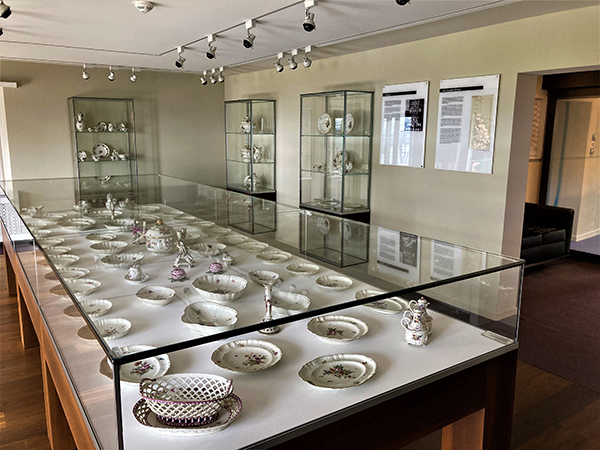
Large table display case with the Einsiedeln Service at the Conrad Ferdinand Meyer House in Kilchberg.
After Siegfried’s death, many of the pieces in his collection were either on the open market or in two private collections. In 1985, they were repatriated to their original place of production and are now in the Zurich porcelain Museum at the C. F. Meyer House in Kilchberg.
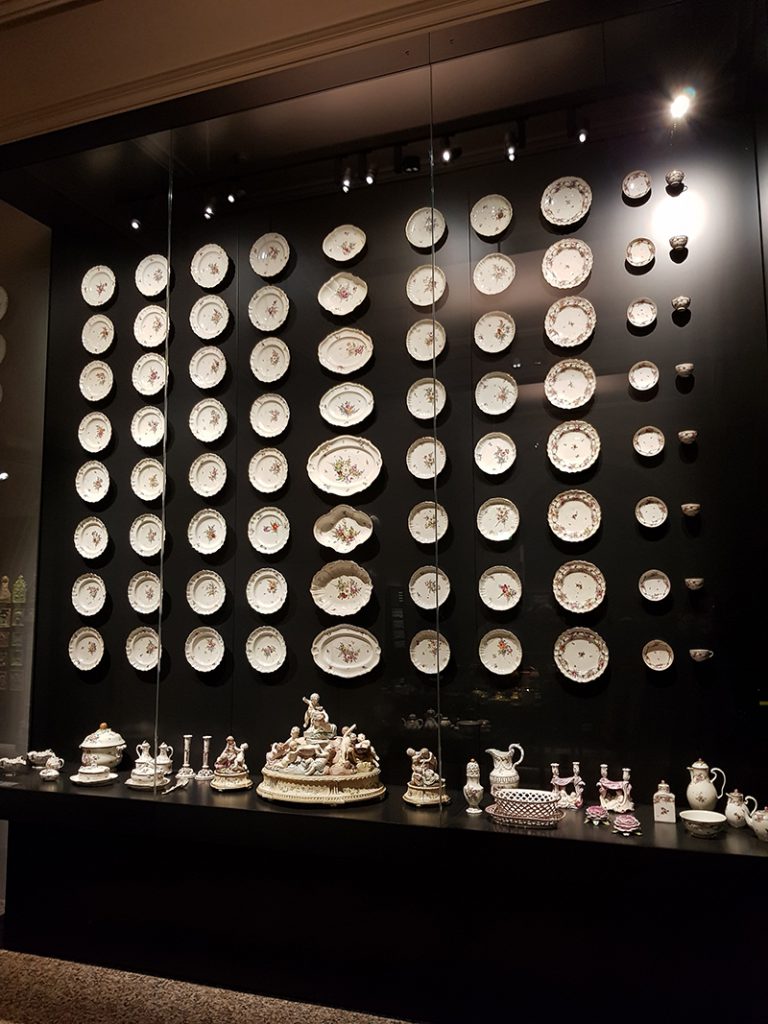
New display of the Einsiedeln Service in the Swiss National Museum in Zurich, 2020.
As well as the three-piece table centrepiece, the Swiss National Museum now owns more than half of the original 72 dinner plates, 16 of the 24 deep soup bowls and a considerable number of the twelve-part coffee- and tea-service, eight so-called ceremonial plates from a total of twelve and many other pieces from the dessert-service. The museum in Kilchberg has 14 dinner plates on display, as well as all the remaining soup bowls, along with numerous round and oval shallow dishes and bowls of different sizes. Also worth mentioning are a few pieces that match the service in terms of their decoration and also appear on the photograph of the service that was taken prior to its sale by the abbey, but are not mentioned in the original invoice from the manufactory (e.g. two oval tureens). Perhaps they were acquired by the abbey separately to complement the service.
The von Salis faience service
Andreas Heege, 2021
Between circa 1770 and 1773, the Zurich porcelain manufactory in Kilchberg-Schooren produced one of only a few known faience services. We know that it consisted of 119 pieces in 1773. As part of his research on the Zurich porcelain manufactory, Franz Bösch carried out an in-depth study on the service and its history (Bösch 2003, 203–215).
In 1895, the Rhaetian Museum was able to acquire part of the service from the heirs of Andreas von Salis (1782–1858) from Chur. At the same time, other pieces were acquired by Heinrich Angst and were eventually bequeathed to the Swiss National Museum. Archival records showed that these pieces originally came from the estate of Peter von Salis-Soglio (1729–1783) in Chur. However, we have no further information on how the service was commissioned. It is assumed that it was acquired or commissioned sometime after 1770 and definitely before 1773, as that was when the first inventory was compiled.
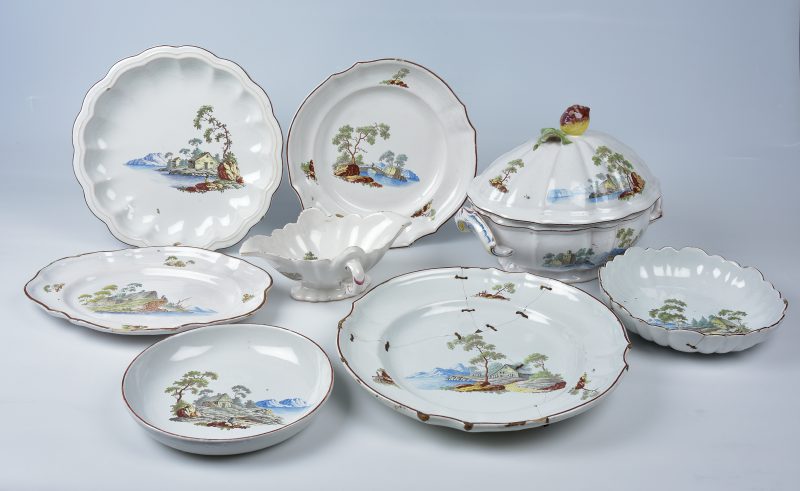
Some pieces from the von Salis service in the collection of the Rhaetian Museum in Chur, dating from the period around 1770.
Today, 36 pieces of this service are in the Rhaetian Museum (RMC H1971.1002-1037), while the Swiss National Museum has 26 pieces (SNM HA-2134–HA-2137, HA-2150–HA-2151, HA-2176; HA-2153 is a sauce boat that is not part of the original service) , one piece is in the Historical Museum of St. Gallen (Friedrich Eugen Girtanner collection, 1880-1956, previously in the Angst collection and then SNM HA-2135, now HVMSG Inv. G-13098), one is in the Conrad Ferdinand Meyer House (CFMH_Bö_0415) and five are in private collections in Switzerland, three of which originally came from the Angst collection and were exchanged for other pieces (HA-2134.8, HA-2136.3, HA-2176.3). The other two were acquired from the Elsa Bloch-Diener collection in Bern and from a flea market in Dortmund. There is no information on the current whereabouts of one or two pieces that were originally in the collection of Ms. de Terra in Zollikon and were sold by the Auction House Stuker in Bern in December 1967 (definitely lot 713 and possibly lot 714). At least one of the plates was acquired by Ms. de Terra from the Swiss National Museum (SNM HA-2135) in 1936 in exchange for another piece from her collection. The whereabouts of another large plate (SNM HA-2136) are also unclear; it was handed over to the art dealer Mathias Göhringer (1889-1941) in 1932. He is known to have been in Baden-Baden until 1933 and then in Freiburg im Breisgau. The whereabouts of the remaining parts of the service that are known from archival records to have been in the possession of the von Salis family in 1895 are unclear.
Only two of the objects in the collection of the Rhaetian Museum, one plate from the Swiss National Museum and a shallow dish from a private collection have a maker’s mark “Z” on the reverse (RMC H1971.1009, RMC H1971.1010; SNM HA-2137). Two plates from the Swiss National Museum have a blue painter’s mark “i” (SNM HA-2176.2, SNM HA-2135.5). Based on the highly characteristic decoration with its uniform brown line along the edge and the vibrant blue of the lakes and mountains in the background, there can be no doubt as to which pieces belong to the service. The painted motifs are very well executed and exhibit a lot of detail. All objects are decorated with idyllic landscapes consisting of lakes and mountains, fanciful architectural motifs, ruins and people (usually seen from behind). The painter is unknown and none of the other products from the Zurich manufactory exhibit the same colour palette. Most objects have small marks on the undersides from where the pins used in the first and second glost firing were broken off and the resulting marks were painted over using a faience glaze in a different shade of white. The same glaze was also used to retouch some of the larger pinholes. The third firing (petit feu) then left pin marks that were not painted over. Many of the objects were therefore fired at least four times, including the first firing, before they were finished (for example RMC H1971.1014). Interestingly, the colour that was fired last, a brown used in the reddish-brown rocks and parts of the tree trunks, in many cases did not fuse very well and sits on the surface rather dully. Some of the plates and dishes have old breaks, which were repaired with wire clamps. It thus appears that the service was in fact used and appreciated on a daily basis.
Im Rätischen Museum sind 36 Keramiken vorhanden:
The collection of the Rhaetian Museum includes 36 ceramics:
1 tureen with pomegranate handle, no rattling balls (RMC H1971.1002; cf. SNM HA-2150).
1 sauce boat (RMC H1971.1003).
2 shallow dishes, oval, with indented/curvilinear rims (RMC H1971.1004, H1971.1005, cf. SNM HA-2151).
3 plates, various diameters, with quatrefoil indented lips (RMC H1971.1006, H1971.1009, H1971.1010, cf. SNM HA-2137).
2 shallow dishes with scalloped walls and horizontal, moulded, wavy rims (RMC H1971.1007, H1971.1008).
1 round, deep dish with lobed rim (RMC H1971.1011).
19 plates with slightly indented rims (RMC H1971.1012– H1971.1031; cf. SNM HA-2135.1-10, HA-2136.1-3, HA-2176.1-2).
7 deep plates (RMC H1971.1032-H1971.1037; cf. SNM HA-2134).
Another 26 objects are in the collection of the Swiss National Museum in Zurich:
1 tureen with pomegranate handle, no rattling balls (SNM HA-2150).
2 shallow dishes, oval, with indented/curvilinear rims (SNM HA-2151.1-2).
1 plate with quatrefoil indented lip (SNM HA-2137).
15 plates with slightly indented rims (cf. SNM HA-2135.1-10, HA-2136.1-3, HA-2176.1-2).
7 deep plates (SNM HA-2134.1-7).
Originally, Heinrich Angst’s collection was slightly larger. We know of six pieces that were exchanged for other objects, which means that at least 32 objects were originally owned by Heinrich Angst and then bequeathed to the Swiss National Museum.
Important collections of Zurich porcelain:
Swiss National Museum in Zurich (Sammlung Heinrich Angst)
Conrad Ferdinand Meyer House, Kilchberg, Canton of Zurich (Collection Franz Bösch)
Translation Sandy Haemmerle
References:
Angst 1905
Heinrich Angst, Zürcher Porzellan, in: Die Schweiz 9, 1905, 9-18.
Bösch 2003
Franz Bösch, Zürcher Porzellanmanufaktur 1763-1790, Porzellan und Fayence, Bd. 1 und 2, Zürich 2003.
Bösch 2008
Das Einsiedler-Service aus der Zürcher Porzellanmanufaktur, Zürich 2008.
Ducret 1958
Siegfried Ducret, Die Zürcher Porzellanmanufaktur und ihre Erzeugnisse. Bd. 1 Geschirre, Zürich 1958.
Mähr 2009
Monika Mähr, service! reiche speisen. Esskultur und Schweizer Porzellan im 18. Jahrhundert, St. Gallen 2009.
Maire 2008
Christian Maire, Histoire de la faïence fine francaise 1743-1843, Le Mans 2008.
Matter 2012
Annamaria Matter, Die archäologische Untersuchung in der ehemaligen Porzellanmanufaktur Kilchberg-Schooren. Keramikproduktion am linken Zürichseeufer 1763-1906 (Monographien der Kantonsarchäologie Zürich 43), Zürich 2012.
Schnyder 1997
Rudolf Schnyder, Das Einsiedler Service von 1775/76 aus der Zürcher Porzellanmanufaktur, in: Kunst + Architektur in der Schweiz, 48. Jahrgang, 1997, Heft 3, 60-63.
Schnyder 2001
Rudolf Schnyder, Der festlich gedeckte Tisch im Kloster. Zürcher Porzellan aus dem Einsiedler Service von 1775/76 im Ortsmuseum Kilchberg, Kilchberg 2001.
Schnyder 2009
Rudolf Schnyder, Zürcher Porzellan : die Figuren der Sammlung Dr. E. S. Kern im Agentenhaus Horgen. Keramik-Freunde der Schweiz, Mitteilungsblatt 122, 2009.

